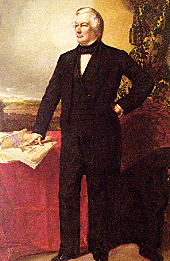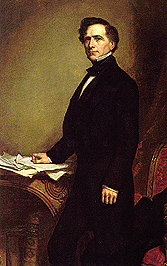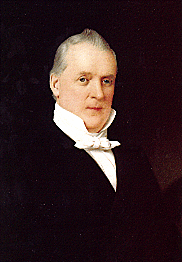Presidents 13-15


Millard Fillmore

The man who replaced Zachary Taylor in the White House was in many ways his
predecessor's opposite. Taylor was a notoriously sloppy dresser; Fillmore was
neat and elegant. Taylor was a southern soldier; Fillmore was a northern
lawyer and politician. Taylor was warm and agreeable; Fillmore often seemed
unemotional. Taylor was a plantation owner who also owned slaves; Fillmore
detested slavery.
Born into a poor family in Summerhill, New York, Millard Fillmore was largely
self-educated. His marriage to teacher Abigail Powers helped elevate his
social status, and by age 23 he began his own law practice. He served as a
Whig in Congress, and as New York State's comptroller general.
In 1848, the tall, white-haired, heavy-set politician from New York State was
chosen by the Whigs to balance the presidential ticket in the campaign of
1848. They believed that Fillmore's political experience and northern
background would help counteract the suspicion many northerners had for the
southern Taylor. The strategy worked, and Taylor and Fillmore were elected.
When Zachary Taylor died in July of 1850, the nation was unsuccessfully trying
to find a solution to the slavery issue. Unlike Taylor, Fillmore supported the
Compromise of 1850. The legislation admitted California into the Union as a
free state, established governments for Utah and New Mexico, and prohibited
slave trade in the District of Columbia. It also called for a tough fugitive
slave law that pleased the South. Fillmore hoped the compromise would heal the
breach between the North and the South, or at least avoid a war.
Fillmore's support helped pass the Compromise of 1850, but led to the death of
his political career. Northern voters opposed the Fugitive Slave Law, and the
Whigs declined to nominate Fillmore again in 1852.
Fillmore ran for President in 1856 as the candidate of the American
Know-Nothing party, but he failed to win. He returned to Buffalo, New York,
where he became chancellor of the University of Buffalo. He died on March 8,
1874, at the age of 74.

Franklin Pierce

Though Franklin Pierce served during a relatively prosperous time in American
history, personal tragedy and the deeply divisive slavery issue hampered his
role as President.
Born in Hillsborough (present-day Hillsboro), New Hampshire, on November 23,
1804, Franklin Pierce entered New Hampshire politics at an early age. He
became a member of Congress in 1833, and four years later, at age 32, Pierce
became the nation's youngest senator. Unfortunately, his wife, Jane, suffered
from tuberculosis, and her ill health forced him to resign from the Senate in
1842.
During the Mexican War, Pierce served as a brigadier general. In 1852, the
Democrats chose Pierce as their presidential candidate after rejecting more
famous senators, such as Stephen Douglas, who took controversial positions on
slavery. Pierce defeated Whig candidate Winfield Scott. At age 48, he became
the youngest person ever to occupy the White House up until that time.
Personal tragedy overshadowed his victory, however, when his son was killed in
a railroad accident. Jane Pierce was so grief-stricken that she did not take
an active role as First Lady.
Early in Pierce's term, the first trade treaty with Japan was finalized.
Despite economic prosperity, the nation was split over slavery issues. The
biggest debate was whether the Union should allow slavery to exist in new
states. Pierce supported Stephen Douglas's Kansas-Nebraska Act, which allowed
the territories to decide this issue for themselves. Yet instead of easing the
tensions between North and South, the Act increased them. Proslavery and
antislavery forces battled for control of Kansas.
Northern Democrats were so angered by Pierce's support for the Kansas-Nebraska
Act that they refused to re-nominate him for President. The party chose James
Buchanan instead.
Pierce returned to New Hampshire, then traveled abroad with his wife. She died
in 1863, and Pierce died on October 8, 1869.

James Buchanan

Perhaps no man ever tried so hard to become President and was so relieved to
leave the job as James Buchanan. He campaigned for the Democratic nomination
three times before he was chosen. By the time his term ended, Buchanan told
president-elect Abraham Lincoln: "If you are as happy in entering the
White House as I shall feel returning to Wheatland, you are a happy man
indeed.
Born near Mercersburg, Pennsylvania, on April 23, 1791, James Buchanan grew up
to be a successful businessman, lawyer, and politician. Andrew Jackson
appointed Buchanan ambassador to Russia from 1832 to 1834. James Polk chose
him to be Secretary of State during the Mexican War, and Franklin Pierce named
him ambassador to Great Britain. Buchanan also served in the House of
Representatives and in the Senate.
The Democrats chose Buchanan to be their presidential candidate in 1856, after
President Pierce angered northern Democrats with his support of the
Kansas-Nebraska Act. Buchanan defeated John C. Fremont, the candidate of the
new Republican party, and ex-president Millard Fillmore, who ran for the
American Know-Nothing party.
Buchanan was a likable, hard-working man who was known to be scrupulously
honest. But he lacked the leadership ability necessary to heal a nation torn
by slavery. Violence in Kansas, the Supreme Court's Dred Scott decision, and
John Brown's raid on Harpers Ferry all increased the anger between the North
and the South. Even though Buchanan opposed slavery, he didn't believe that
the national government should dictate the decisions of individual states.
Buchanan was soon heartily tired of the office he had wanted for so long. He
did not seek a second term. By the time he left office in 1861, the southern
states had begun to secede, and he left the crisis in Abraham Lincoln's hands.
Buchanan retired to Wheatland, his Pennsylvania estate, where he wrote his
memoirs. He died there at the age of 77 on June 1, 1868.

All images of Presidents are courtesy of whitehouse.gov
Information taken from Software titled "American Heritage The History of
the United States for Young People.
The copyright belongs to: Forbes
Inc. and Byron Preiss Multimedia Company. Thank You!

Washington, Adams, Jefferson
Madison, Monroe, Adams
Jackson, Van Buren, Harrison
Tyler, Polk, Taylor
Fillmore, Pierce, Buchanan
Lincoln, Johnson, Grant
Hayes, Garfield, Arthur
Cleveland, Harrison, Cleveland
McKinley, T. Roosevelt, Taft
Wilson, Harding, Coolidge
Hoover, F. Roosevelt, Truman
Eisenhower, Kennedy, Johnson
Nixon, Ford, Carter
Reagan, Bush, Clinton
Bush, ????, ????
|

|
All graphics and
pages are copyright © 1997 - 2008 Pages 4 Ever
(except where noted). Do not take, copy, steal, plagiarize or use in any
way, shape or format without the express written permission of Pages
4 Ever.
Some backgrounds and graphics made from clipart acquired from ArtToday, Boxed Art,
friends, my own imagination, and/or
graphic CD collections that I have purchased. If you find anything on this site
that you have copyright to, and can prove it, please let me know and I will
gladly either remove it or place a link back to you, whichever you prefer.
If you should find any broken links, please drop us a line and let us know the
exact URL the broken link is on. Thank you.
|

|
![]()





